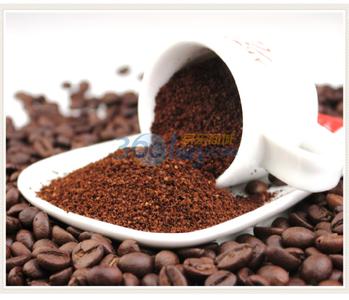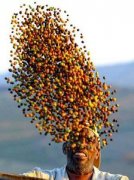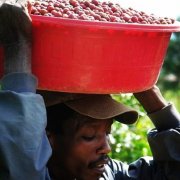Freshness is how the life of coffee determines the freshness of coffee beans.
There are three steps: smell, see, and peel.

Smell: put the coffee beans close to the nose and smell them deeply to see if you can clearly smell the aroma of the coffee beans. If so, the coffee beans are fresh enough. On the contrary, if the aroma is weak, or has begun to appear greasy, it means that the coffee beans are not fresh at all.
No matter how much effort you put into grinding and cooking such coffee beans, it is impossible to make a good cup of coffee.
Look: spread the coffee beans on your hands, determine the origin and variety of coffee beans, and determine whether the coffee beans are roasted evenly.
Peel: take a coffee bean and try to peel it off by hand. if the coffee bean is fresh enough, it should be easy to pull away, and it will have a crisp sound and feeling. If the coffee beans are not fresh, you will find that you have to work hard to get rid of a bean.
Another important point to observe when peeling off the coffee beans is to see if the firepower is uniform when baking. If it is uniform, the outer skin and inner layer of the beans should be the same color.
If the color of the surface layer is obviously much darker than that of the inner layer, it means that there may be too much firepower during baking, which will also affect the aroma and flavor of coffee beans.
The difference in taste between large coffee beans and small coffee beans
For the same kind of coffee, the bigger the bean, the higher the grade, the smaller the bean, the lower the grade, and the cheaper it is. Of course, there are differences in taste. The bigger the beans, the stronger the coffee. However, in addition to high-grade products, the classification of other coffee is not very strict, for example, the central grade beans can account for 60%. Then beans one level higher than this level and beans at a lower level will each account for 20% at the same time. Therefore, sometimes it is roasted according to the standard of the marked central grade, and the other 40% of the coffee cannot be roasted under the best conditions.
The division of new beans and old beans in coffee beans and the time to market
The taste of new coffee and old coffee baked in the same variety and degree will be significantly different, of course, new beans are more fragrant. Although the moisture of the new bean will be greatly lost and the color will turn white after several years of preservation, the fragrance will not be greatly affected.
Important Notice :
前街咖啡 FrontStreet Coffee has moved to new addredd:
FrontStreet Coffee Address: 315,Donghua East Road,GuangZhou
Tel:020 38364473
- Prev

Coffee beans recommend Ethiopia Yejia Sheffield mocha
As the hometown of coffee, thousands of years of planting history and processing tradition in Ethiopia have created high-quality washed Arabica beans. Ethiopia's Yirgacheffe coffee is one of the most unique coffee beans in the world today: it has a strong aroma of flowers, lemon, strong acidity but soft and smooth taste.
- Next

Coffee beans knowledge what is coffee flat beans, round beans, elephant beans
Learning Coffee: coffee knowledge: some berries contain only one seed (for unknown reasons), which takes up the internal space of the entire berry and looks like two smaller flat beans stick together; this kind of bean, which we call peaberry, often appears on the top of a young coffee tree. Usually we buy coffee beans, one side is flat, there is a crack on it, this is the coffee cherry
Related
- Guji coffee producing area of Guji, Ethiopia: Humbela, Shakiso, Wulaga
- What is the most expensive variety of Qiloso in BOP multi-variety group?
- How to store the coffee beans bought home?
- Why are Yemeni coffee beans so rare now?
- Ethiopian Sidamo all Red Fruit Sun Sun Santa Vini Coffee beans
- SOE is mostly sour? What does it mean? Is it a single bean? what's the difference between it and Italian blending?
- Is Italian coffee beans suitable for making hand-brewed coffee?
- How to choose coffee beans when making cold coffee? What kind of coffee beans are suitable for making cold coffee?
- Just entered the pit to make coffee, what kind of coffee beans should be chosen?
- Can only Japan buy real Blue Mountain Coffee? What are authentic Jamaican Blue Mountain coffee beans?

